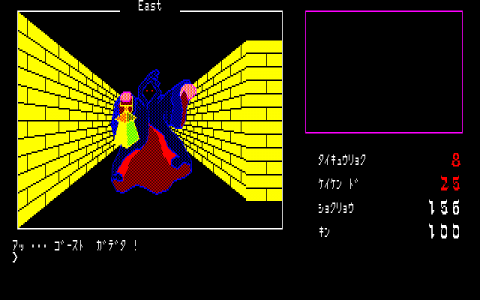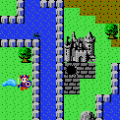Koei’s final RPG for 1983 follows the classic Ultima formula closer than any of the other games shown thus far. It’s also one of the more accessible games of its period, as both the PC-80 and PC-88 versions are well-preserved. The title screen opens with a wizard who majicks open a door, from which then a swarm of bats comes flying out.
Character creation is simple: Chose between five classes – Soldier, Cleric, Magic User, Thief and Ninja (bit of a Wizardry influence there?) – then roll your stats. The flipping numbers for those stop by pressing escape, you can try as often as you’d like, and the process is really fast. After that you get five additional points to distribute at leisure, but with a decent roll, those don’t really make much of a difference.
The stats are, from left to right: Stamina (HP), Attack Strength, Speed, Skillfulness and Charisma.
Each game starts at a random location on an island that constitutes the entire overworld. You can only hope to be spawned near a city – while it’s possible to survive one enemy attack, another one is very likely fatal. The stats shown at the lower righthand side are stamina, experience, food (which is reduced with every step) and money.
Like in Ultima, you enter a city or a dungeon by stepping on its field and pressing “E”. The towns themselves are once again played in text adventure mode, like in Dragon & Princess. And even though the game is called Dungeon, I found the cities to be the true impenetrable labyrinths. I even found a guide in Japanese for the game, which explains that one can get healed and buy equipment by using (T)ransact at the right locations. But I can never seem to find the armory or the temple where this is supposed to happen. Whenever I try to (T)ransact with people, they just seem to take my money and do nothing else, or start to swear at me.
It seems the people actually have their daily schedules and walk around the city, and when no one’s there, you can (S)teal stuff. If someone catches you, though, you get thrown in the titular dungeon. The catacombs are truly massive and seem to span the entire island underground. It has a few lower levels that are smaller, but the base level is ridiculously huge.
Enemies also walk around the dungeon in semi-real time, like in the first two Ultima games, before that series adopted Wizardry‘s party approach. Like in Ken to Mahou, there are several options for attack and defense, but their actual effects are just as dubious. Since I’ve never managed to buy any equipment or get myself healed, the same “2 enemies to die” rule from the field applies here as well, unfortunately. The monster designs are once again pretty cool as far as the typical D&D monsters go (That Japanese guide has images of them all, albeit in scaled-down form. Ours appear a bit downsized on the blog, but when you save them or open them in a new tab, they’re actually in the original resolution):
Here are some screenshots of the low-res PC-80 version:


